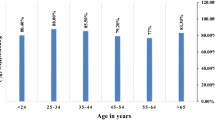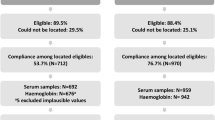Abstract
Helicobacter pylori (previouslyCampylobacter pylori) is now accepted as the major cause of type B gastritis and thus what is known about the epidemiology of type B gastritis can reasonably be transferred toH. pylori. We used a specific ELISA for anti-H. pylori IgG to study the prevalence ofH. pylori infection in a population of lower socioeconomic class from Hyderabad, India. The results from India were compared to studies from other parts of the world. Two hundred thirty-eight individuals ages 3 to 70 participated. The frequency ofH. pylori infection increased with age (P<0.01) and was >80% by age 20.H. pylori infection was present in 79% of the population studied; there was no gender-related difference in prevalence ofH. pylori infection. IgG antibody against hepatitis A (HAV) was rapidly acquired in Hyderabad; in a subset of 58 children between the ages of 3 and 21 tested, the frequency of anti-HAV was 98.2%. The prevalenc ofH. pylori infection increases with age in both developed and developing countries. The high age-specific prevalence ofH. pylori infection in developing countries is probably a reflection of the lower socioeconomic level of those areas.
Similar content being viewed by others
References
Graham DY, Adam E, Klein PD, Evans DJ Jr, Evans DG, Hazell SL, Alpert LC, Michaletz PA, Yoshimura HH: Epidemiology ofCampylobacter pylori. Gastroenterol Clin Biol 13:84B-88B, 1989
Graham DY, Klein PD, Opekun AR, Boutton TW, et al: Epidemiology ofCampylobacter pylori infection: Ethnic considerations. Scand J Gastroenterol 23 (suppl 142): 9–13, 1988
Massarrat S, Paidlik A, Pittner P, Schmitz-Moorman P, Wurbs M: The role of certain habits and various diseases in the occurrence of gastritis. Hepato-Gastroenterol 30:249, 1983
Edwards FC, Goghill NF: Aetiological factors in chronic atrophic gastritis. Br Med J 2:1409–1415, 1966
Cotran RS, Kumar V, Robbins SL (eds). Robbins Pathologic Basis of Disease. Philadelphia, WB Saunders, 1989, p 843
Evans DJ Jr, Evans DG, Graham DY, Klein PD: A sensitive and specific serologic test for detection ofCampylobacter pylori infection. Gastroenterology 96:1004–1008, 1989
Dwyer B, Kaldor J, Tee W, Raios K: The prevalence ofCampylobacter pylori in human populations.In Campylobacter pylori and Gastroduodenal Disease. BJ Rathbone, RV Heatley (eds). Oxford, Blackwell Scientific Publications, 1989, pp 190–196
Dwyer B, Nanxiong S, Kaldor J, Tee W, Lamber J, Luppino M, Flannery G: Antibody response toCampylobacter pylori in an ethnic group lacking peptic ulceration. Scand J Infect Dis 20:63–68, 1988
Jones DM, Eldridge J, Fox AJ, Sethi AJ, Whorwell PJ: Antibody to the gastric campylobacter-like organism (“Campylobacter pylori”)-clinical correlations and distribution in the normal population. J Med Microbiol 22:57–62, 1986
Kosunen TU, Hook J, Rautelin HI, Myllyla G: Agedependent increase ofCampylobacter pylori antibodies in blood donors. Scand J Gastroenterol 24:110–114, 1989
Al-Moagel MA, Evans DG, Abdulghani ME, Adams E Evans DJ Jr, Malaty HM, Graham DY: Prevalence ofHelicobacter (formallyCampylobacter) pylori infection in Saudi Arabia and comparison of those with and without upper gastrointestinal symptoms. Am J Gastroenterol 85:944–948, 1990
Graham DY, Adam E, Klein PD, Evans DG, Evan DJ Jr, Alpert LC, Yoshimura HH, Brown M, Michaletz PA: Comparison of the prevalence of asymptomaticC. pylori infection in the United States: effect of age, gender and race. Gastronterology 96:A 180, 1989
Klein PD, The Gastrointestinal Physiology Working Group of Cayetano Heredia, and The Johns Hopkins Universities. Graham DY, Opekun AR, Skeley S, Evans DG, Evans DJ Jr: High prevalence ofCampylobacter pylori (CP) infection in poor and rich Peruvian children determined by 13C urea breath test (13C-UBT). Gastroenterology 96:A260, 1989
Mitchell HM, Lee A, Berkowicz J, Barody T: The use of serology to diagnose activeCampylobacter pylori infection Med J Aust 149:604–609, 1988
Megraud F, Brassens-Rebbe M-P, Denis F, Belbouri A, Hoa DQ: Seroepidemiology ofC. pylori infection in various populations. J Clin Microbiol 27:1870–1873, 1989
Morris A, Nicholson G, Lloyd G, Haines D, Rogers A, Taylor D: Seroepidemiology ofCampylobacter pylori. NZ Med J 99:657–659, 1986
Vira D, D'Anastasio CD, Holton J, Dowsett JF, Londei M, Bertoni F, Beltrandi E, Grauenfels P, Salmon PR, Gandolfi L:Campylobacter pylori in abattoir workers: Is it a zoonosis. Lancet 2:725–726, 1988
Dwyer B, Kaldor J, Tee W, Marakowski E, Raios K: Antibody response toCampylobacter pylori in diverse ethnic groups. Scand J Infect Dis 20:394–350, 1988
Alpert LC, Graham DY, Evans DJ, Jr Yoshimura HH, Hazell SL, Evans DG, Klein PD: Diagnostics possibilities forCampylobacter pylori infection. Eur J Gastroenterol Hepatol 1:17–26, 1989
Paul JR: Historical and geographical aspects of the epidemiology of poliomyelitis. Yale J Biol Med 27:101–113, 1954
Paul JR: A History of Poliomyelitis. New Haven, Yale University Press, 1971
Walton M, Melnick JL: Poliomyelitis antibodies in two differing socioeconomic groups within the same city. Yale J Biol Med 27:350–370, 1955
Dienstag JL, Szmuness W, Stevens CE, Purcell RH: Hepatitis A virus infection: new insights from seroepidemiologic studies. J Infects Dis 137:328–340, 1978
Frosner GG, Papaevangelou G, Butler R, Iwarson S, Lindholm A, Courouce-Pauty A, Haas H, Deinhardt F: Antibody against hepatitis A in seven European countries. I. Comparison of prevalence data in different age groups. Am J Epidemiol 110:93–99, 1979
Hsu HY, Chang MH, Chen DS, Lee CY, Sung JL: Changing seroepidemiology of hepatitis A virus infection in Taiwan. J Med Virol 17:297–301, 1985
Frosner G, Wilers H, Muller R, Schenzle D, Deinhardt F, Hopken W: Decrease in incidence of hepatitis A infections in Germany. Infection 6:259–260, 1978
Perez-Perez GI, Taylor DN, Bodhidatta L, Wongsrichanaiai J, Baze WB, Dunn BE, Escheverria PD, Blaser MJ: Seroprevalence ofH pylori infections in Thailand. J Infect Dis 161:1237–1241, 1990
Author information
Authors and Affiliations
Additional information
This work was supported by the research funds from the Department of Veterans Affairs; by grant DK 39919 from the National Institute of Diabetes and Digestive and Kidney Diseases, and by the generous support of Hilda Schwartz.
Rights and permissions
About this article
Cite this article
Graham, D.Y., Adam, E., Reddy, G.T. et al. Seroepidemiology ofHelicobacter pylori infection in India. Digest Dis Sci 36, 1084–1088 (1991). https://doi.org/10.1007/BF01297451
Received:
Revised:
Accepted:
Issue Date:
DOI: https://doi.org/10.1007/BF01297451




